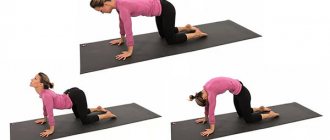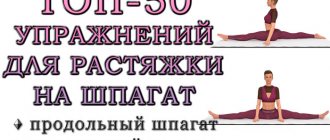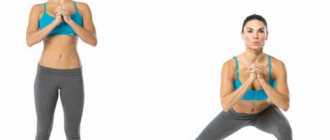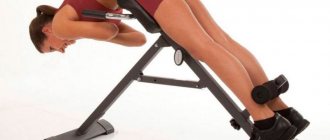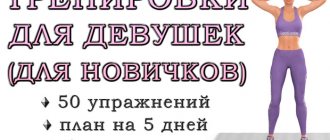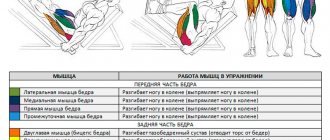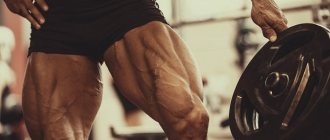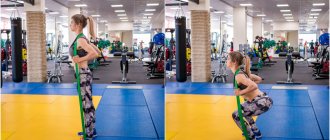How to stretch your thigh muscles? A flexible, elastic body is a person’s dream. It is possible to try to achieve your plans. The right set of exercises performed daily will help you achieve your cherished goal. The front surface of the thigh is a delicate part; you need to stretch it carefully. The area is pumped at an accelerated pace, becomes very noticeable, “swollen”, to prevent this, you will need to give up excessive weights when working with the front surface of the thigh. The muscles of the legs are pumped much less often than other parts of the body.
Do not keep your back in a neutral position while stretching
Maintaining a neutral back falls under the category of “good stiffness.” When you bend your hips, there should be no rounding in your lower back.
When stretching the front surface of the thigh, the opposite problem occurs - the lower back overextends and the person arches forward.
And when stretching the upper body, many people do it with an arched lower back:
Stretching for neurological problems
Intervertebral disc problems with radicular symptoms in the legs may be worsened by hamstring strains. These muscles can become “stiff” in response to excessive lordosis (arching) of the lower back, which unevenly loads the discs and can lead to protrusions and hernias.
The muscles of the back of the thigh are attached to the pelvis at the back from above and to the leg below the knee - from below. The central nervous system strains them to keep the pelvis from further tilting, so that the deflection does not increase until spondylosis - a fracture of the vertebrae.
Similar problems can happen if people with thoracic outlet syndrome do aggressive stretching of the upper body. If the nerves don't glide the way they should, the last thing you should do is tug on them.
This again includes stretching the lumbar muscles. They are often spasmed to fix the problem area. Their deliberate relaxation with manual therapy, massage or stretching can provoke an exacerbation of hernias. The main rule of working with the lower back: if you don’t know, don’t interfere (almost like with electricity).
Quadriceps[edit | edit code]
What are you stretching:
Anterior thigh muscles (rectus)
What are you abbreviating:
Buttock muscles (gluteus maximus) and hamstring muscles (hamstrings)
How many times to repeat:
10 per side
How long to hold:
2 seconds
Lie on your side with your knees pressed to your chest (“curl”). Relax your neck by resting your head on the surface you are lying on or on a pillow. Place your bottom hand under your bottom leg and use your palm to grasp the outside of your foot. If you can't reach your foot, simply stabilize your knee. Tighten your abdominal muscles to avoid rolling over. With your top hand, grab the shin (or ankle, or toe) of your top leg. If you cannot bend your leg enough to reach your foot with your hand, use a rope. Tie it around your ankle and grab the ends. The knee should be bent and the leg should be parallel to the surface on which you are lying. Tighten your hamstrings and gluteus maximus and walk your top leg back as far as possible. At the end of the stretch, you can help yourself a little with your hand.
One head it's good, but two better…
Assistant, let the athlete do everything himself, but at the end help him a little. Pull slightly and lock for 2 seconds. If the athlete is very tight, he can relax his knee and you can help him move his leg back and then bend his knee. Have the athlete contract their hamstrings to bring their heel to their buttocks. Help by pulling slightly and holding for 2 seconds.
Note
. Top view, head in position 12.
| Left-hand side | Right side | ||||
| Range | Position on the dial | Range of motion degree | Range | Position on the dial | Range of motion degree |
| Red range Too tight | 12.00-9.00 | 0—90 | Red range Too tight | 12.00-3.00 | 0°-90° |
| Yellow range Fine | 9.00-7.45 | 90°-127,5 | Yellow range Fine | 3.00-4.15 | 90°-127,5° |
| Green range Athlete's norm | 7.45-6.00 | 127,5°-180° | Green range Athlete's norm | 4.15-6.00 | 127,5-180° |
| Blue range Hypermobility | 6.00-5.30 | 180°-195° | Blue range Hypermobility | 6.00-6.30 | 180°-195° |
Do not tighten your glutes when stretching the front of your thighs.
Aggressive stretching of the hip joint while placing the knee on the floor causes the head of the femur to move forward out of the acetabulum and damage the joint capsule. Therefore, you need to balance the movement with tension in the gluteal muscles - the gluteus maximus pulls the femoral head back during extension, and the anterior hip capsule is not loaded.
If you already have pain in the front of the hip joint, stretching the hip extensor muscles (its front surface) is not recommended - this may worsen the problem.
Hip abductors[edit | edit code]
What are you stretching:
Muscles of the outer thighs (gluteus medius, vastus lateralis, tensor fascia lata and iliotibial bandalis)
What are you abbreviating:
Muscles on the inside of the thighs (gracilis, major, long-term, short-term), pectineus and quadriceps
How many times to repeat:
10 per side
How long to hold:
2 seconds
Lie on your back with your legs extended. Take the rope at both ends, forming a loop. Place the foot of the leg you will be working on in the loop and wrap the rope around the outside of your ankle with the ends of the rope on the inside. Strengthen your knee. Rotate the second leg inward slightly and rotate the first leg slightly outward. (Eventually both feet will be pointing in the same direction.)
From the groin, using the adductors, bring the leg across the midline of the body, heel first, slightly above the leg you are not working. Pull the rope a little. Use the rope for a little help at the end of the stretch. Don't pull your leg into position or your hip will hurt. Remember not to bend your knee.
One head it's good, but two better…
Helper, help your client keep the knee and leg turned outward. Let the athlete do everything himself and use the rope, but at the end give him a little help. Place one hand on your outer thigh and the other on your heel. Pull slightly and hold for 2 seconds. As the joint opens, each subsequent stretch can be a little deeper, and the leg will go diagonally farther.
Note
. Starting position: Your feet are at the 6 o'clock position.
| Left-hand side | Right side | ||||
| Range | Position on the dial | Range of motion degree | Range | Position on the dial | Range of motion degree |
| Red range Too tight | 6.00-7.00 | 0-30° | Red range Too tight | 6.00-5.00 | 0-30 |
| Yellow range Fine | 7.00-7.30 | 30°-45° | Yellow range Fine | 5.00-4.30 | 30°-45“ |
| Green range Athlete's norm | 7.30-9.00 | 45°-90° | Green range Athlete's norm | 4.30-3.00 | 45-90° |
| Blue range Hypermobility | 9.00-9.15 | 90°-97,5° | Blue range Hypermobility | 3.00-2.45 | 90°-97,5° |
Stretch where it’s not the muscles, but the bone blocks
There are many things that can limit the range of motion in a joint. Sometimes the problem is in the bones when they no longer fit together so that the movement in the joint is complete and complete - this is called congruence. Bone “calluses” and growths can be, for example, in the shoulder joints or ankles in front. Sometimes the cause is injury, the stiffness of the joint capsule. Before you delay, it is better to find out the reason.
Treatment of thigh muscle strain in adults
Treatment tactics are determined by the severity of the injury. If the sprain is of the first and second degree, then conservative treatment is possible, which has several components:
Drug therapy. The resulting injury causes pain that can persist for a long time. Therefore, your doctor may recommend taking painkillers from the class of non-steroidal anti-inflammatory drugs. According to indications, muscle relaxants, anti-inflammatory drugs, calcium supplements, etc. are prescribed.
Rest the injured area. The basis of treatment is to avoid actions that aggravate the course of the injury and provoke complications. It is recommended not to put any weight on the injured limb for the first 48 hours after injury. After 48 hours, warming and anti-inflammatory ointments can be used. To limit movements during the acute period of injury, orthoses are recommended, which are selected by the doctor conducting the treatment. Movement during the acute period should be carried out with the help of a cane or even crutches, it all depends on the complexity of the injury.
It is better not to load the injured limb for the first 48 hours, and after that you can use warming and anti-inflammatory ointments. Photo: Sora Shimazaki/Pexels
Physiotherapy. Physiotherapy methods are selected individually and depend on the type of injury and associated injuries.
Diagnostics
It begins with a survey and clarification of the circumstances surrounding the formation of the injury, which sometimes helps determine treatment tactics and predict possible complications. At the appointment, the traumatologist will assess mobility, muscle condition, and conduct diagnostic tests. To exclude other pathologies with similar symptoms, it is necessary to conduct additional examination methods:
- X-rays will help exclude fractures, which can also be combined with sprains;
- Ultrasound to assess the condition of the joint, identify early symptoms of hemarthrosis - hemorrhage into the joint cavity;
- MRI and CT are the most informative examination methods for diagnosing ligament damage and assessing their condition;
- arthroscopy is a visual diagnostic method that allows you to assess the condition of the joint from the inside.
Based on these data, it is possible to make a diagnosis and determine treatment tactics.
Modern methods of treatment
All modern methods of treating various injuries are aimed not only at eliminating the cause itself, but also at preventing complications. Therefore, treatment and rehabilitation measures begin already in the acute period.
Therapeutic physical education or therapeutic exercises exclusively under the guidance of an experienced specialist can begin just a few days after the injury. Doing the exercises on your own is fraught with serious complications. Only a doctor will select exercises that will really help.
In the subacute period, kinesiotaping as part of complex therapy has proven itself to be effective in reducing the severity of edema and speeding recovery. Tapes improve lymph drainage and reduce swelling. These elastic bands are used to strengthen muscles and ligaments.
A third degree sprain requires surgical treatment; there are no other options. But modern treatment methods involve minimally invasive surgery with a short recovery period.
Good to know
Shoulder dislocation: how to help the victim
Stretch while resting between sets
When working with weights, it is important that the target muscles are involved in the work at the same time, and the antagonists relax. During stretching between sets, some of the muscles may relax and will be slightly delayed in engaging in work during the next approach with weight, this can lead to injury. In order for the muscles to work synchronously, so that all muscles are equally ready for the load, it is better not to stretch between approaches.
The second problem is that stretching makes you weaker for a while. It reduces the effect of elastic deformation of connective tissue. What does it mean? When we perform an exercise with weights, it occurs not only due to muscle contraction, but also due to the help of the connective tissue that surrounds the muscles - fascia, ligaments, etc. It is an elastic fabric that can stretch and compress like a spring. This is how the body saves a little energy: muscle contraction requires energy, but connective tissue contraction does not, it works like a spring and provides energy purely mechanically.
Warnings
Talk to your doctor or physical therapist about whether you can do these exercises if you have had ligament damage in this muscle group.
Muscle stretching involves many muscles, allowing you to work even those that we do not usually use. The benefits of exercise are obvious: the effects of stress are prevented, weight is normalized, the cardiovascular system begins to function normally, and the body’s overall resistance is developed. Training is gradually becoming a part of life. Stimulate your own interest by doing family or group activities.
Rock and bounce while stretching
When tissue is stretched in an unusual way, receptors on it read information and send a signal to the spinal cord that there is a threat of rupture. It responds with a reflex contraction of the muscle to stop the dangerous stretch. This is called the myostatic reflex.
In an untrained person, it turns on quickly and plays a protective role, preventing injuries. This looks like a complete lack of flexibility, when the amplitude in the joint is very small, and it is impossible to move further.
But if you stretch regularly, over time the nervous system becomes more and more stable and the reflex brakes are pushed back further. This is how a person becomes more and more flexible.
But springing, swinging with a “bounce” during stretching, using inertia to sink deeper or reach further, you can get injured - the myostatic reflex will not work in time. Therefore, move slowly, smoothly and only forward.
